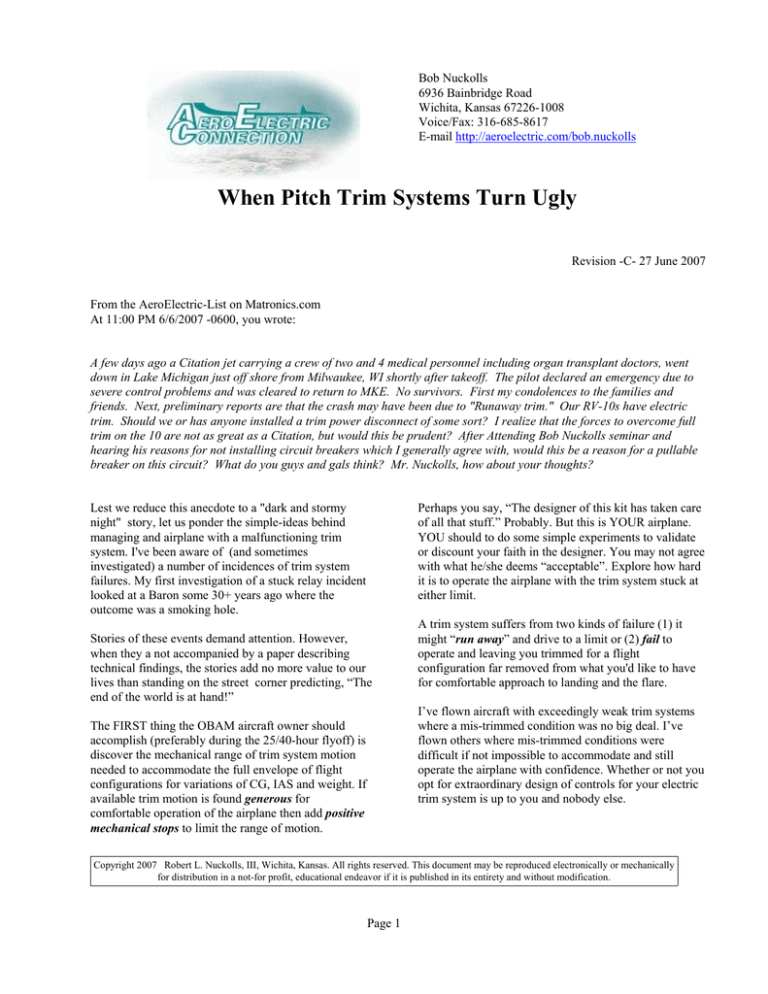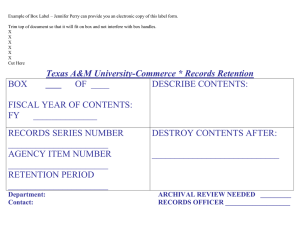
Bob Nuckolls
6936 Bainbridge Road
Wichita, Kansas 67226-1008
Voice/Fax: 316-685-8617
E-mail http://aeroelectric.com/bob.nuckolls
When Pitch Trim Systems Turn Ugly
Revision -C- 27 June 2007
From the AeroElectric-List on Matronics.com
At 11:00 PM 6/6/2007 -0600, you wrote:
A few days ago a Citation jet carrying a crew of two and 4 medical personnel including organ transplant doctors, went
down in Lake Michigan just off shore from Milwaukee, WI shortly after takeoff. The pilot declared an emergency due to
severe control problems and was cleared to return to MKE. No survivors. First my condolences to the families and
friends. Next, preliminary reports are that the crash may have been due to "Runaway trim." Our RV-10s have electric
trim. Should we or has anyone installed a trim power disconnect of some sort? I realize that the forces to overcome full
trim on the 10 are not as great as a Citation, but would this be prudent? After Attending Bob Nuckolls seminar and
hearing his reasons for not installing circuit breakers which I generally agree with, would this be a reason for a pullable
breaker on this circuit? What do you guys and gals think? Mr. Nuckolls, how about your thoughts?
Perhaps you say, “The designer of this kit has taken care
of all that stuff.” Probably. But this is YOUR airplane.
YOU should to do some simple experiments to validate
or discount your faith in the designer. You may not agree
with what he/she deems “acceptable”. Explore how hard
it is to operate the airplane with the trim system stuck at
either limit.
Lest we reduce this anecdote to a "dark and stormy
night" story, let us ponder the simple-ideas behind
managing and airplane with a malfunctioning trim
system. I've been aware of (and sometimes
investigated) a number of incidences of trim system
failures. My first investigation of a stuck relay incident
looked at a Baron some 30+ years ago where the
outcome was a smoking hole.
Stories of these events demand attention. However,
when they a not accompanied by a paper describing
technical findings, the stories add no more value to our
lives than standing on the street corner predicting, “The
end of the world is at hand!”
A trim system suffers from two kinds of failure (1) it
might “run away” and drive to a limit or (2) fail to
operate and leaving you trimmed for a flight
configuration far removed from what you'd like to have
for comfortable approach to landing and the flare.
I’ve flown aircraft with exceedingly weak trim systems
where a mis-trimmed condition was no big deal. I’ve
flown others where mis-trimmed conditions were
difficult if not impossible to accommodate and still
operate the airplane with confidence. Whether or not you
opt for extraordinary design of controls for your electric
trim system is up to you and nobody else.
The FIRST thing the OBAM aircraft owner should
accomplish (preferably during the 25/40-hour flyoff) is
discover the mechanical range of trim system motion
needed to accommodate the full envelope of flight
configurations for variations of CG, IAS and weight. If
available trim motion is found generous for
comfortable operation of the airplane then add positive
mechanical stops to limit the range of motion.
Copyright 2007 Robert L. Nuckolls, III, Wichita, Kansas. All rights reserved. This document may be reproduced electronically or mechanically
for distribution in a not-for profit, educational endeavor if it is published in its entirety and without modification.
Page 1
My most recent experience with a trim failure involved
sticking relays (note plural semantics here) in roll trim
on a bizjet. In this case, with roll trim hard-over, flying
the airplane is uncomfortable but manageable. Another
case involved failure of an actuator to bring a stabilizer
position out of Mach cruise configuration. This required
something on the order of 180 pounds of pull on the
yoke to put the airplane into an attitude conducive to
orderly contact with the earth. Without going into a
long dissertation of simple-ideas upon which these and
other events were based, let's consider the situations
unique to the airplane you intend to build and operate.
Once you have limited mechanical travel to practical
and useful limits, explore the stick forces necessary to
manage the aircraft with trim set to either extreme. This
is the first step of a meaningful failure mode effects
analysis (FMEA). Yeah, our brothers on the certified
side are nowadays fond of Functional Hazard
Assessments, MTBF studies, and reliability trees . . .
big piles of paper.
I'll suggest that it is much more useful to assume that
every component of the system is guaranteed to fail at
some point in time. Evaluate the consequences of each
failure possibility and craft a recovery plan. I find this
approach easily supported by logical assessment of the
simple-ideas and totally free of mathematical models
where any assumptions are made beginning with a faith
in the model's value. Each cause-effect-and-recovery
plan is based upon repeatable experiments. Every
potential failure can be generated for the purpose of
investigating the validity of the recovery plan.
was made available to us . . . but the idea that a single
failure like one stuck relay is capable of producing
unintended motion in the trim system is mystifying.
In virtually every system I’ve had the pleasure of
designing, design goals included (1) no single failure
within the product be capable of producing a runaway
condition and (2) any single failure that marches off in
the direction of potential runaway shall be monitored
and annunciated. Cessna works out of the same Aircraft
Certification Office that I do . . . if such a condition in
fact made it to production, I’ll suggest that somebody
stubbed their toe here.
Examination of the relay, part number B46229,
at Magnetech Struthers Dunn, Darlington,
South Carolina, showed no evidence of
electrical arcing or other damage. Wear was
noted on the moving parts of the relay, and
operation of the relay verified the condition
found at Cessna. The designed operational life
for this relay is 50,000 cycles. The number of
cycles per flight is defined as the number of
times that pitch trim is engaged/disengaged by
the autopilot, and can vary depending on
weather (turbulence) and other flight
conditions.
Let’s examine the phrase “no evidence of electrical
arcing or other damage”. This photo is of a set of
contacts for a relay used in a bizjet trim system. These
contacts were subjected to a standard test protocols for
Assuming your airplane's out-of-trim handling qualities
are more than YOU choose to deal with, I’ll suggest
you craft a Plan-B to deal a runaway malfunction. Let's
consider words quoted from the accident investigation
of one incident (1).
The Pitch Trim Printed Circuit Board, part
number 6518351-5, serial number 0154, was
examined and functionally tested at the Cessna
Airplane facilities in Wichita, Kansas. Testing
showed a repeatable fault in the operation of
the K6 relay, resulting in the relay contacts
remaining closed. This condition would be
representative of the autopilot remaining
engaged and a voltage (signal) present to
drive continuous nose-down trim to the
elevator servo.
Hmmm . . . there may be more to this paragraph than
reliability. Such testing is accomplished periodically on
production parts to verify continued compliance with
specifications. These contacts show severe metal transfer
(due to arcing under rated load) but the relays were not
sticking nor were they damaged in a way that prevented
Copyright 2007 Robert L. Nuckolls, III, Wichita, Kansas. All rights reserved. This document may be reproduced electronically or mechanically
for distribution in a not-for profit, educational endeavor if it is published in its entirety and without modification.
Page 2
a relay from performing as advertised.
experienced in the accident airplane.
On the other hand, here are a pair of mating contacts
that show only the tiniest hints of electrical stress after
perhaps 2,000 cycles and they were failing to make
connection! Visual inspection of these contacts did not
reveal why an expected event didn’t happen, yet the
malfunctioning contacts were visually “perfect”.
This paragraph seems to confess existence of a single
point failure that would produce a runaway. Further, the
only way to halt effects of the failure was to pull the trim
motor circuit breaker. Managers for every program I’ve
worked have stated emphatically that, ”Pulling a
breaker is NOT an acceptable procedure to recover
from an emergency condition ”. Breakers are not
located, labeled and grouped for the purpose of quickly
finding and operating them to bring impending
emergency under control.
Personnel from the FAA Wichita Aircraft
Certification Office reported that post accident
simulator testing of the elevator flight control
system revealed that full deflection of the trim tab
(trailing edge up) would require extremely high
control wheel forces to achieve level flight.
I offer these anecdotes to show that while many words
offered in accident analysis are factual, they add no
value when they fail to illuminate and then explain the
significance of the observation. I’ve witnessed cases
where well meaning but uninformed individuals banned
particular manufacturers of devices use on their
airplanes based on no better information than “Brand X
relay sticks more often than Brand Y.”
Decisions were made to purge the inventory of “BrandX” relays and replace them with “better” and more
expensive relays without ever having fixed root cause
for the sticking. The importance of the paragraph I cited
from the accident analysis is an inference that the relay
in question was sticking closed from a mechanical
failure and not an electrical failure . . . a notion worthy
of some skepticism and further investigation.
ADDITIONAL INFORMATION
The investigation revealed that the K6 relay
failure would constitute a single-point type
failure in the electric pitch trim system. Pulling
the circuit breaker, which is called for by the
checklist in the event of a trim runaway, would
have arrested the trim movement provided the
circuit breaker was opened prior to the trim
reaching its stop. Further examination of the
system revealed that the autopilot autopilot/trim
disengage switch would not have disengaged the
electric trim motor during the type of failure
Again, factual as far as it goes . . . but what is an
“extremely high control wheel force”? The Beechjet was
certified based on a demonstration that two pilots could
safely land the airplane with the trim system stuck in full
nose down (Mach cruise) condition. A number like 180
pounds of stick-force comes to mind. A couple of weight
lifters in the front seats might call this “no-big-deal”,
you and I would certainly call it “extreme” but both
terms are un-quantified and not useful for making an
judgement as to the difficulty of the task or mitigating
risk for an uncomfortable of not hazardous termination
of flight.
I offer the foregoing words to illuminate the value (or
lack thereof) in reading these reports and applying any
real design or operational significance to them. So let’s
turn our thoughts back to the OBAM aviation world and
evaluate your airplane’s ability and likelihood of forcing
a bad day in the cockpit.
Let us assume that you’ve accomplished out-of-trim
flight experiments and decided that a trim system failure
places a burden on you as pilot that you’ve considered
unmanageable or sufficiently undesirable to do
something about it. Let us further assume that you are
willing to increase parts count and complexity in some
way that reduces risk of having to endure the event.
The trim system runaway issue has been considered for
decades. In fact, there’s a long standing protocol for
testing a proposed design that goes something like this.
While in stabilized flight for the most critical condition
(usually high speed cruise), the pilot puts his hands in
Copyright 2007 Robert L. Nuckolls, III, Wichita, Kansas. All rights reserved. This document may be reproduced electronically or mechanically
for distribution in a not-for profit, educational endeavor if it is published in its entirety and without modification.
Page 3
his lap. The test engineer initiates a simulated runaway
condition. The pilot cannot react to a perception of
runaway onset for 3 seconds. After three seconds, he is
directed to accomplish whatever recovery process has
been offered in the aircraft flight manual. During
recovery the airplane shall not depart level flight by
more than xx degrees and shall not poke the edge of the
envelope for safe operations.
The technique for passing this test in the early days was
to simply slow the trim rates until the a 3-second
reaction delay no longer poses a hazard for recovery
from the failure condition. This worked pretty good
except . . . trim rates appropriate to high-speed cruise
were so slow that trimming operations during approach
to landing were frustratingly slow.
I was privileged to craft what I believe was the first
servo speed-controlled trim system first for the Lear 55
and ultimately as a retrofit to the fleet of 30-series
Lears. The system offered a 4:1 range in trim speeds for
high speed (flaps up) and low speed (flaps extended
10+ degrees) operations. Pilots loved it. Electronics for
controlled the motor featured two, independently
controlled, series switches for motor current. Both had
to close to effect motor motion. Failure of either one to
open after the command was relaxed caused a TRIM
FAIL warning light to illuminate.
detected at pre-flight and probably noticed in flight as
well.
Now, if you have a super-whippy autopilot, it’s likely
that the electronics of the autopilot will want to “talk” to
an already existing pitch trim actuator. This doesn’t
change the considerations for manual pitch trim but does
place some responsibility on the A/P designer to
consider single points of failure along with an orderly
plan for annunciating a failure and offering a Plan-B for
recovery.
If you don’t want to go the Press for Trim Enable
route, consider the equivalent of the Wheel Master
Disconnect button. The schematic in Figure 1 describes
one approach to a Master Disconnect system capable of
handling any and all power paths to motor driven flight
controls. The relay used needs one more pole than the
number of systems being controlled. Alternatively, the
relay can be a combination of 2 or more relays with the
coils wired in parallel.
The goal is to provide a means by which operation of a
single switch preferably on the control stick or wheel
grip can be quickly operated at the first perception of a
malfunctioning flight controls motor. The system is reset
by a second button elsewhere . . . perhaps right next to
the Master Disconnect warning light.
Additionally, pitch trim power was routed through what
was call the “Wheel Master Disconnect” system . . .
pushing this button caused power to be removed from
every motor that was capable of driving a flight control
surface.
Okay, what kinds of techniques might we consider for
the installation of electrically powered trim systems
such that probability of runaway is exceedingly low or
zero?
First, consider a two-switch operation for trim systems.
The first switch is the classic spring loaded, pitch-up,
pitch-down operating switch. The second is a Trim
Enable switch . . . also spring loaded that is normally
open and wired in series with pitch trim motor power.
This switch is perhaps built into the grip such that it
must be squeezed to enable trim before the pitch-up,
pitch-down switch will function. This is stone simple
and offers the very solid, simple-idea that you’re not
going to get simultaneous failures in two separate
switches . . . while failure of any one switch is easily
There are a variety of control and monitoring
philosophies that offer interesting features but I can
deduce nothing simpler and more direct than the
technique cited.
Copyright 2007 Robert L. Nuckolls, III, Wichita, Kansas. All rights reserved. This document may be reproduced electronically or mechanically
for distribution in a not-for profit, educational endeavor if it is published in its entirety and without modification.
Page 4
Notes:
(1) http://www.ntsb.gov/ntsb/brief2.asp?ev_id=20030724X01192&ntsbno=SEA03FA147&akey=1
Figure 1. Master Flight Motors Disconnect System.
Copyright 2007 Robert L. Nuckolls, III, Wichita, Kansas. All rights reserved. This document may be reproduced electronically or mechanically
for distribution in a not-for profit, educational endeavor if it is published in its entirety and without modification.
Page 5




